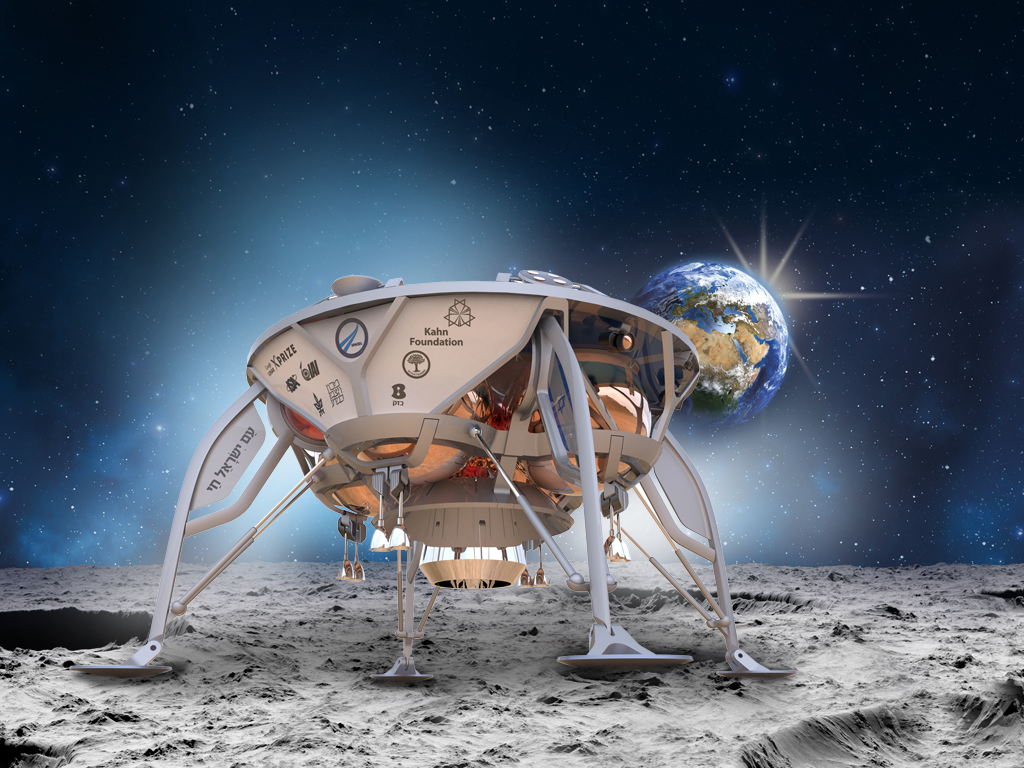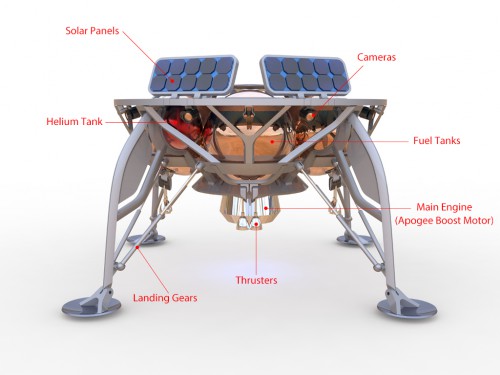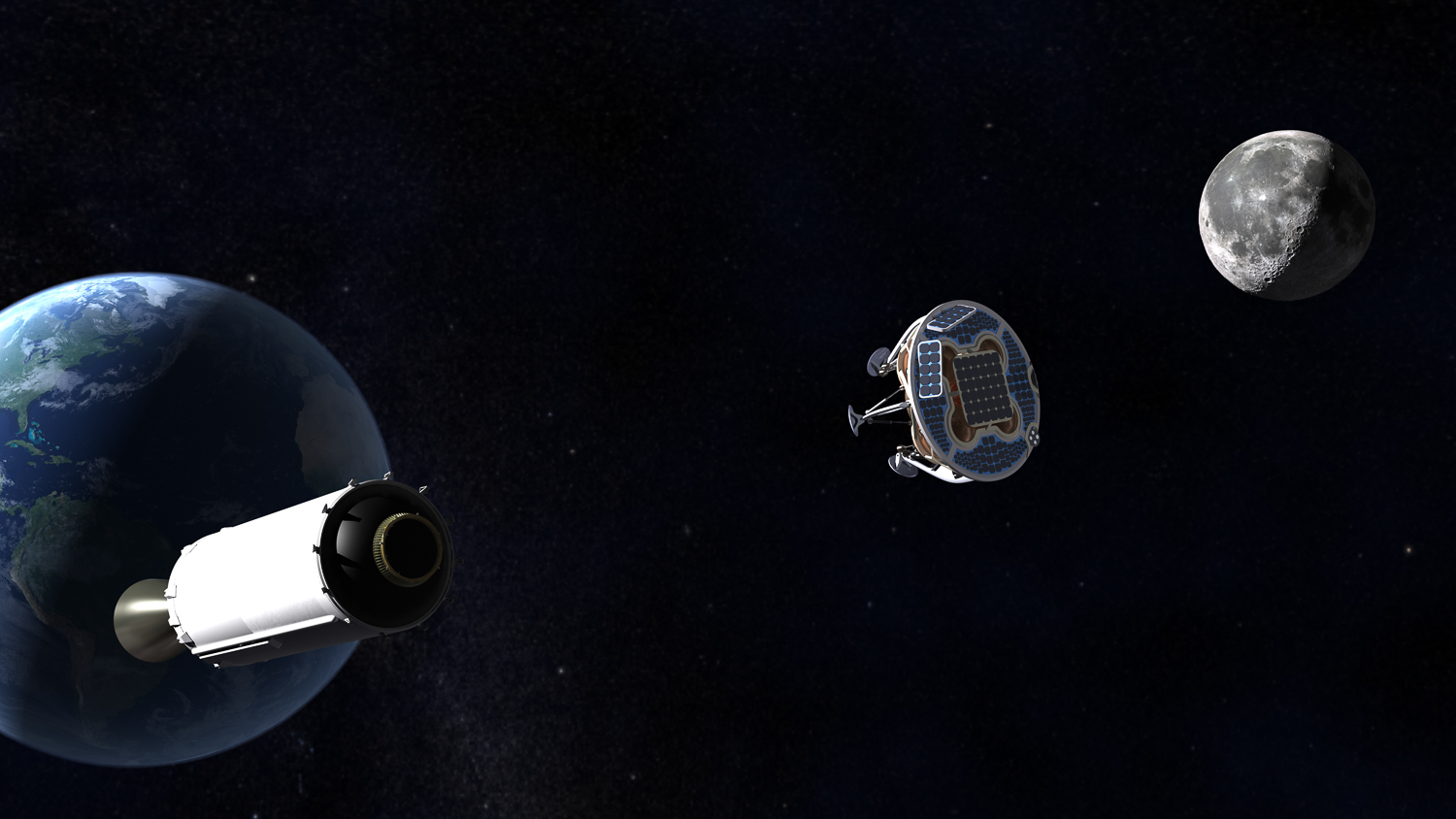
Teams from around the world have been competing to win the global Google Lunar XPRIZE race to the moon for close to a decade, each building a privately-funded robotic spacecraft and mission to be the first to land on the lunar surface – with little or no government assistance (90% of the funding must be private). The challenge aims “to foster innovation and entrepreneurship in space through low-cost, efficient access to the moon”, with each of the 16 teams from the United States, Italy, Malaysia and elsewhere having to secure launch contracts by the end of this year, with the deadline for the moon being December 31, 2017.
Today, the non-profit Israeli team SpaceIL announced they have secured their launch contract to fly, and land, the world’s first private lunar mission. SpaceX will provide the rocket with their Falcon-9, and the mission aims to launch sometime in the second half of 2017 as a secondary payload.

“We are proud to officially confirm receipt and verification of SpaceIL’s launch contract, positioning them as the first and only Google Lunar XPRIZE team to demonstrate this important achievement, thus far,” said Bob Weiss, vice chairman and president of XPRIZE. “The magnitude of this achievement cannot be overstated, representing an unprecedented and monumental commitment for a privately-funded organization, and kicks off an exciting phase of the competition in which the other 15 teams now have until the end of 2016 to produce their own verified launch contracts. It gives all of us at XPRIZE and Google the great pride to say, ‘the new space race is on!’”
SpaceIL securing the first launch vehicle is also important to the other teams as well, because – per the terms of the Google Lunar XPRIZE deadline – “If no team has provided XPRIZE and Google with notification of launch contract by December 31, 2015 the competition will conclude.”
Now that at least one team has a launch contact all of the other remaining teams now have until December 31, 2016 to also secure their launch contracts in order to move forward in the competition.
A place in the history books and a $20 million Grand Prize awaits the first team to soft-land an unmanned spacecraft on the moon, travel 500 meters (1640 feet) across the surface, and send high-resolution images and video back to Earth.
SpaceIL’s flight would mark the first Israeli mission to the moon, joining just 3 other countries in the exclusive club; the United States, the former Soviet Union, and China.
“The notion of the small state of Israel being added to this exclusive list look more promising than ever,” said SpaceIL CEO Eran Privman. “Last year we made significant strides toward landing on the moon, both in terms of project financing and in terms of the engineering design and now, we are thrilled to finally secure our launch agreement. This takes us one huge step closer to realize our vision of recreating an ‘Apollo effect’ in Israel: to inspire a new generation to pursue Science, Engineering, Technology, and Math (STEM).”
SpaceIL’s success will be not only a source of pride for Israel, but it will introduce the world to new and innovative ways to explore space; that and the space industry could become a major growth engine for the Israeli economy in the coming years.
The company’s spacecraft is small, about the size of a dishwasher, and is designed to “hop” across the moon instead of “roving”, or driving, across it. After landing on the surface it will light its engines again and “hop” the required 500 meters to win the competition, a design that idea that is shared among other teams as well, such as U.S.-based Moon Express.
SpaceIL wants to do more than just “hop” across the moon too, they want to investigate its magnetic field and push the frontiers of lunar geophysics, with the results to be published and disseminated to NASA and scientists around the world.

“SpaceIL is particularly interested in deciphering the secrets kept by the moon’s crustal rocks,” said SpaceIL CEO Eran Privman in a Nov. 2014 Op-Ed authored by him and other mission researchers. “Although magnetized rocks were discovered decades ago, and astronauts returned some samples to Earth for research, the origin of the magnetic field presents an enigma — and an opportunity. Therefore, in its mission to the moon, SpaceIL will integrate a scientific experiment — the Lunar Magnetometer (LMAG) — to study the nature of this phenomenon.
The experiment will be conducted with the Weizmann Institute of Science in Rehovot, Israel, led by Oded Aharonson, who directs the Center for Planetary Sciences there. Aharonson is a member of several science teams for NASA spacecraft venturing to other bodies in the solar system, such as the Mars Exploration Rovers and the Lunar Reconnaissance Orbiter (LRO). The design and build of the LMAG sensor is being led by Prof. Christopher Russell of the University of California, Los Angeles, who’s team has also provided a similar instrument for NASA’s InSight lander, which will launch next year to land on Mars.
Earlier this year two other teams, Astrobotic from the U.S. and Hakuto from Japan, announced that they each had signed with SpaceX for a late 2016 launch as well. However:
“While what they announced is very exciting indeed, they have not yet initiated the verification process with XPRIZE,” said XPRIZE Senior Director Chanda Gonzales today in response to our inquiry. “So this announcement today (from SpaceIL) was be the first, verified launch contract as part of our competition, and the one that officially extends the competition to give the remaining 15 teams through the end of 2016 to demonstrate their own contracts, to complete a mission by Dec 31 2017.”
In that deal both Astrobotic and Hakuto would launch together, and land on the moon together, then drive across the surface in a race to be the first to reach 500 meters.
U.S.-based Spaceflight Industries will provide launch services to SpaceIL, and will manifest their spacecraft as a co-lead spot, which will sit in a designated capsule among a cluster of secondary payloads. Once the capsule separates from the launcher, it will automatically release the spacecraft, which will use advanced navigation sensors to guide it to the lunar surface, with engineers in a mission control room standing by to remotely send commands and corrections as needed.
“We’re excited to work closely with the SpaceIL team to help them realize their mission of getting to the moon”, said Curt Blake, president of Spaceflight’s launch business. “It’s very gratifying to play an integral part in SpaceIL’s quest to win the Google Lunar XPRIZE.”
Something else to keep in mind: considering the months of delays stemming from the loss of the SpaceX/NASA CRS-7 Dragon space station resupply mission several months ago, one has to wonder if XPRIZE would extend their competition deadline if potential SpaceX delays caused a launch slipping past 2017.
“While we do want the teams to be successful, we have no plans on extending the 2017 deadline,” said Gonzales.
WATCH: “Back to the Moon For Good / Google Lunar XPRIZE”
Be sure to “Like” AmericaSpace on Facebook and follow us on Twitter: @AmericaSpace
.






“After landing on the surface it will light its engines again and ‘hop’ the required 500 meters to win the competition, a design that is unique among the teams.”
I like your article Mike Killian. Thank you!
However, maybe it is not “a design that is unique among the teams”.
“While many teams are developing rovers to traverse the lunar surface after landing, the MX-1 lander will take off again and ‘hop’ to another landing site to fulfill the travel requirement.”
From: ‘Moon Express Buys Rocket Lab Launches for Lunar Missions’ by Jeff Foust October 1, 2015
Clearly, hopping and flying across the Moon is useful!
Also see: ‘Arne — Sublunarean Explorer’ by Robinson, M. S.; Thanga, J.; Wagner, R. V.; Hernandez, V. A. Abstract: “We propose a simple and cost effective reconnaissance of the Mare Tranquillitatis Pit with Arne, a small lander (<130 kg) that carries three flying microbots (or pit-bots) each with mass of 3 kg. Objectives serve key science and exploration needs.”
Thanks James, “unique” came from SpaceIL CEO, so my mistake for not digging further. Have updated accordingly